While our business has enjoyed a fairly consistent amount of success over the last few years, we are always looking for new opportunities to grow.
In January, our very own Spencer Haws did a podcast interview with Travis Ketchum who is the founder of Contest Domination – a contest management tool.
He described how small businesses could generate enormous amounts of new leads and sales by running effective contests, and provided actual examples of how it had worked for other businesses.
This interview was an “aha” moment for us.
Why hadn’t we ever tried this with our business?
We decided to take a run at our first contest and we were very pleased with the results. I want to share some of the key principles we followed and show how this plan might work well for your business too.
Table of Contents
1. Avoid Generic Giveaways
One of the first pieces of advice we heard in our interview with Travis was to avoid the trap of doing a generic giveaway.
How many times have you seen an advertisement to enter to win a free iPad or a free big screen TV?
These types of giveaways appeal to almost everyone; who wouldn’t want a free iPad?
At first, having a contest with wide appeal seems like a great idea. After all, you’ll cast a wider net and probably get more entries since almost everyone wants what you’re giving away.
The problem with being too general with your giveaway is that the point of the contest is to generate leads and sales.
What do we know about people who enter to win an iPad?
They want an iPad.
So if you’re a cosmetic dentistry practice and you’re giving away an iPad, you might get 3,000 entries. But how many of those 3,000 entries are leads that might turn into revenue for your dental services?
Perhaps there are a few people coveting a free iPad that are also looking for teeth whitening, but there is certainly no direct connection between the two.
It’s quite possible that you could end up with 3,000 contest entrants and zero solid leads.
The Alternative:
What if, on the other hand, the cosmetic dentist decides to give away something like free professional teeth whitening instead of an iPad?
What do we know about people who enter to win professional teeth whitening?
They want professional teeth whitening.
Since professional teeth whitening is a service the dentist offers, he can feel confident that almost everyone who enters the contest wants what he sells.
This is huge!
More than likely, a teeth whitening giveaway won’t be as popular as an iPad giveaway. Maybe instead of 3,000 entries to the iPad giveaway, they end up with 150 for teeth whitening.
Remember, the whole point of doing this is to generate leads and ultimately sales. So in terms of leads, give a cosmetic dentist the choice of a list of 3,000 people who like iPads and 150 people who want teeth whitening and see which one he takes.
Key Takeaway
We sell a keyword research software, Long Tail Pro, so it seemed obvious that giving away a copy of our own software would fit the bill. However, we still wanted to brainstorm to think about a unique spin we could put on it so it would be even more appealing to our subscribers and maybe even current customers.
2. Everyone Is A Winner!
Once you’ve run a contest that is targeted at your ideal customer, it’s important to make everyone feel like a winner. Nobody wants to walk away empty-handed, right?
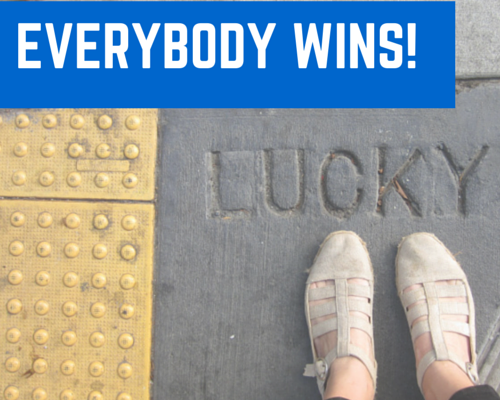
Travis shared a case study with us about a small company that sells ribbon printers. As the name suggests, these are the types of printers you need to print on ribbons that you might give away for first place at the county fair pie contest.
So needless to say this is a very niche product.
In their case, they ran a contest giving away a ribbon printer. While they only had 310 entries into the contest, what did we learn about these 310 people from our earlier example?
(Say it with me)
They want a ribbon printer.
At the conclusion of the contest, they did something very important to turn their new leads into paying customers. They made sure that everyone was a winner by offering a truly limited time sale on that same ribbon printer they had entered to win.
In their case, they made the discount available for 72 hours and generated about $6,000 in new sales.
Because of their success, they ended up running the same giveaway 2 more times.
Each time, they generated a similar number of sales by offering a “everyone wins” discount to those who had entered the contest but didn’t win. Besides the immediate revenue from these 72 hour discounts, they’ve also generated other sales from leads that they acquired from the contest.
In total, they generated about $35,000 in revenue from about 1,300 contest entrants.
Key Takeaway
We had offered discounts before, and they were always well received. However in this case we really wanted to offer something that felt more exclusive to our subscribers and contest entrants, so everybody could feel like a “winner” knowing that they couldn’t get this deal elsewhere.
Our Course of Action:
Based on what we had learned about other successful contests, we decided to do a giveaway for something that we’d never even offered for sale before – a lifetime subscription to our software.
We’ve always sold our software product as a one-time fee ($97) for the “standard” version, and then an optional monthly subscription of $17 which gets you access to a few other premium features. We call this enhanced version “Long Tail Platinum.”
We thought giving away a lifetime license, where you get the Platinum features forever, would be a big draw for both our current customers and for new leads that were interested in keyword research.
We also thought that this would be a fantastic test case to see how many people expressed interest in paying a larger fee upfront, so they wouldn’t have to pay monthly fees going forward.
On top of that, since we had never offered a lifetime subscription before we thought that this was an offer that we could sell for a limited time at the conclusion of the contest.
Promotion Strategy
Remember that our goal for running a contest is leads and sales – not necessarily in that order.
We were starting from a strong position as we have a fairly large list of current customers, who’d love the opportunity to win the Platinum version of our software for life.
So we thought that promoting the giveaway to our customers and email subscribers would be critical for sales. After all, according to a study done by Marketing Metrics “the probability of converting an existing customer is 60 percent to 70 percent. The probability of converting a new prospect, on the other hand, is only 5 percent to 20 percent.”
In our case, we have thousands of customers using our standard and Platinum software who see value in it and already trust the Long Tail Pro brand. We thought that some percentage of them would want the opportunity to buy in for life.
The second point of emphasis was to get new leads.
Fortunately the contest system we used (Contest Domination) made sharing the contest a very simple process for contestants. We set up our contest so that after you enter, you are prompted to email up to 3 friends with a pre-made template telling them about the contest.
We gave people 2 extra entries into the contest for each email they sent (up to 3), and then 8 bonus entries for sending all 3 referral emails.
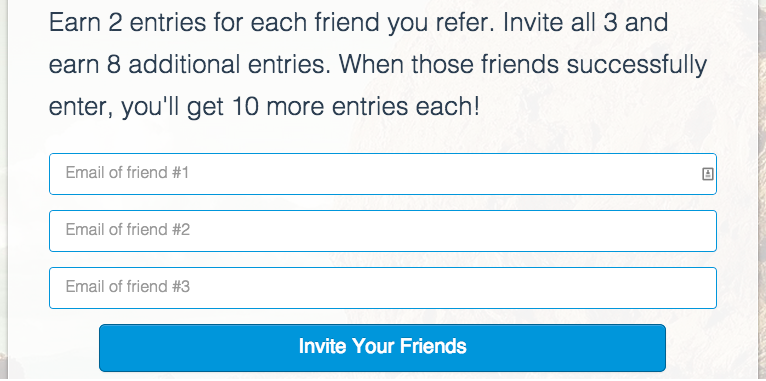
The next step was incentivizing them to share on social media. We had pre-made Facebook posts and Tweets that people could send out in a matter of seconds.
Since it used their unique referral link, they would earn 10 additional entries any time someone signed up via their personal link.
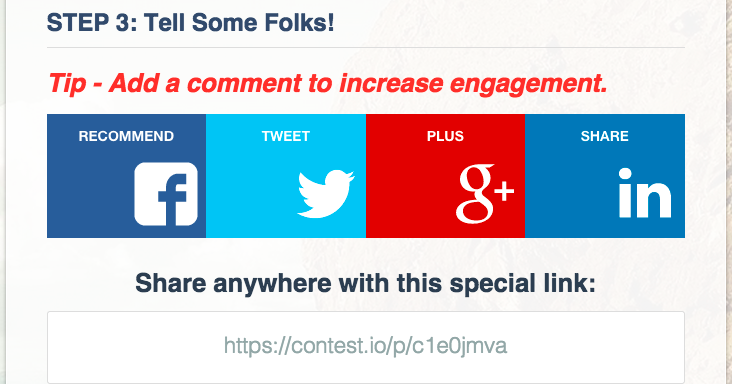
Both of these referral prompts were built into the sign up process, so you really couldn’t miss them.
We thought having this built-in incentive would help us reach new leads – people who may have no idea what Long Tail Pro is.
While we understood that these fresh leads would be less likely to pay a premium price for a software they weren’t familiar with, we knew that we would have the opportunity to get them on our free trial, and maybe turn them into a customer down the road.
So how did it go?
The Entry Numbers
Total unique entries: 5,129
Total number who shared the contest with at least 1 other person: 1,350
This means that over 25% of people who entered our contest shared it via email or had a verified referral sign up on social media. 17 people ended up with over 100 entries because so many people signed up from their referral link. Since every shared referral link is unique, we were able to track how many entrants came from our main contest link (direct) and how many came from someone’s referral link. Here is a breakdown of those numbers:
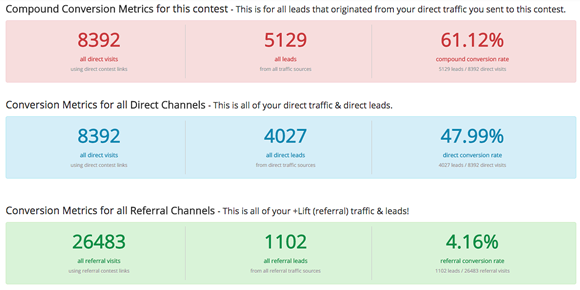
Notice that the visits from referral links were very high, but the conversion rate was much lower than our direct contest link. This seems to make logical sense as many of the people going to our direct link were either existing customers or email subscribers and many of the referral visits were colder leads.
We also reached out to friends in our industry about the contest, and many of them sent emails, tweets, etc. helping spread the word for us.
We set up a short link of www.longtailpro.com/contest and with help from other influencers, a number of our “direct” entrants were also new leads for us.
Fortunately we did use an integration with our CRM to tag our contestants. Based on that, we were able to determine that 1,749 new leads were created as a result of this contest.
The Sales Numbers
While I won’t share exact dollar amounts, it’s important to highlight how we approached this from the sales perspective. We left the contest open for almost 3 weeks, and at the conclusion of it we offered a lifetime subscription for sale – but only for 72 hours.
We communicated this by creating a landing page that announced the winner, and then made the announcement that, for the first time ever, you could buy a lifetime license exclusively on our contest page.
For what it’s worth, we also used a plug-in called Page Expiration Robot that counted down the hours and ultimately shutdown the page when 72 hours had passed.
One other challenge we faced was that we had 3 types of entrants in our contest:
- People who didn’t own our software
- People who owned the standard (non-Platinum) version of our software
- People who owned and subscribed to our Platinum software.
We offered a lifetime license for non-customers at $297, which is about what you’d pay to own Platinum for 1 year. For our current customers, we simply asked them to log into their software for a discounted offer. We offered lifetime access to standard and Platinum customers for $247 and $197, respectively.
So… how did it turn out?
We really had no precedent for this, so we had no idea what to expect as far as sales. The contest concept and the lifetime license were both new to us.
We ended up doing incredibly well with our 72 hour sale.
In fact, our revenue just from sales of the lifetime license in those 72 hours was greater than our total revenue for the entire previous month, January 2015. Of the sales that we made, here is the breakdown of the 3 different types of customers (numbers represent percentage of total buyers):
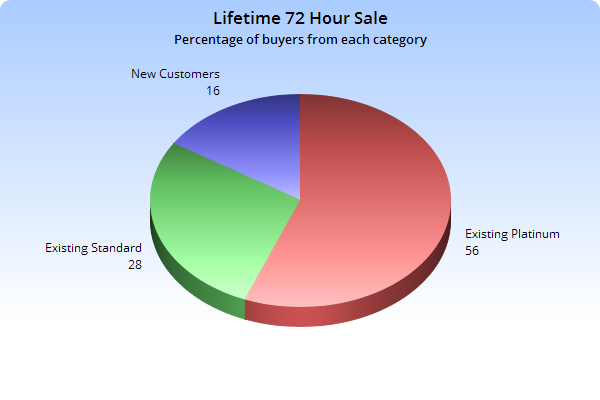 – 56% of buyers were existing Platinum monthly subscribers
– 56% of buyers were existing Platinum monthly subscribers
– 28% of buyers owned our standard Long Tail Pro, but were not paying monthly for Platinum
– 16% of buyers were brand new and had never purchased our product.
Beyond the lifetime sales, we’ve also had new leads that have done a free trial of our product, and purchased the the standard license since the contest.
Key Takeaways
Overall the contest was a huge success for us. Here are some the key takeaways for you to consider if you plan on using a contest for your business.
1. Error on the side of being too niche specific, instead of too general.
We decided to give away a different package of something that we already offered, and people loved it.
In particular, when it came time to sell, 84% of our sales were from people who already owned our product and saw value in paying more to have lifetime access.
You don’t necessarily have to give away your main product or service. However, you should be able to make a clear connection between the desire to win your giveaway and the likelihood of also needing whatever it is you sell.
An example that I heard at Traffic & Conversion Summit was giving away a set of guitar picks.
Who would want guitar picks?
People who either own a guitar or are planning to buy a guitar. So maybe you sell guitars or accessories like strings, guitar lessons, cases, etc. – you can make a clear connection that the guy who wants free guitar picks may also want what you have to sell. So when you announce the winner, you could unveil an exclusive deal on your best guitar strings.
The key is the quality of the lead. The more specific your giveaway, the more targeted your lead.
2. Understand your customer’s triggers.
We talked about ending your contest by having a landing page that both announces the winner, and announces a special/limited time offer.
This cannot be overlooked.
If we would have ended our contest and simply offered the same standard version of our software that you can buy on our website whenever you want, I highly doubt we would have had the kind of success we did.
Especially if you are going to invite your email subscribers to your giveaway (and you should), then you want something unique that they haven’t seen you offer before that will get them excited. At the very least, offer discounted pricing or if keeping the standard price, maybe add on free bonuses that they’ve never seen before.
The other trigger we tapped into was the fear of loss, or scarcity. It’s among one of the strongest psychological triggers we have – we don’t want to miss out on things.
The important thing about using scarcity is, don’t lie about it.
If you say that the discount is going away in 72 hours, take the discount down in 72 hours. We had setup our countdown timer to automatically redirect to a new page that still announced the winner, but no longer included a link to buy the lifetime license once 72 hours had passed.
If you say “we’ll never sell this service again” and then next week you offer it for sale again, your credibility will take a hit. So if you’re going to use scarcity, be honest about it.
Another form of scarcity could be that you are only selling a certain amount of your product or service.
If you gave away a free 1 hour SEO consultation, maybe at the end you could sell the same service, but only make 10 sessions available. By using a limited quantity, you can typically charge a premium price because some people are willing to pay more if you let them.
ConsumerPsychologist.com talks about different pricing strategies and uses Intel computer chips as an example. When they first come out, they are often sold at a high price because of the great price elasticity; meaning some people will pay a lot more money because they want to get it fast, and get first access.
3. Incentivized sharing is critical.
While it’s true that most of our immediate sales came from our existing list, if we would have only sold to the 16% who were new customers it would have still been a fantastic 3 days for us.
Besides that, getting new leads that you can begin to build a relationship with and turn into fans and customers down the road is also a key benefit of running a contest.
We wouldn’t have had nearly as many new leads without the built in sharing incentives. I’m not an expert in all of the contest management systems out there, but I would highly recommend that you find one that makes sharing the contest quick and easy.
Sending an email later on and asking people to tell their friends is one thing, but asking people to share at the point of entry and telling them they’ll get a bunch of more chances to win takes the motivation to another level.
Having 25% of your contestants invite other people to enter makes a sizable impact.
Wrap Up
We were thrilled with the results of our first contest and have started to think about other ways we can leverage these kinds of giveaways for our business.
In this case, we were able to effectively try out a “new” product offering with a lifetime access offer. So in addition to the other benefits, we also learned a little more about pricing and the kinds of offers that our customers are interested in. Local search engine optimization is also to be taken into consideration if your business addresses local markets.
I encourage you to think about how this can work for your business, and I’d be happy to answer any questions that I can.
